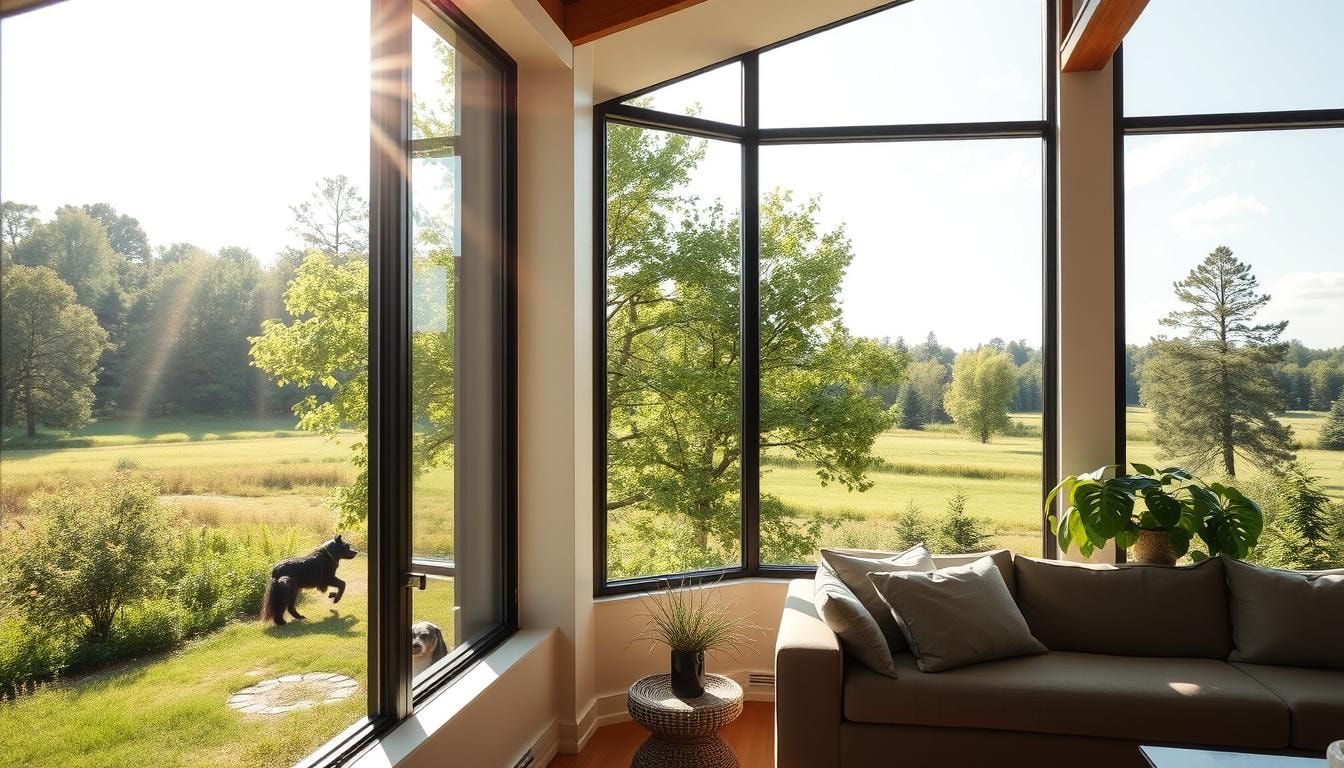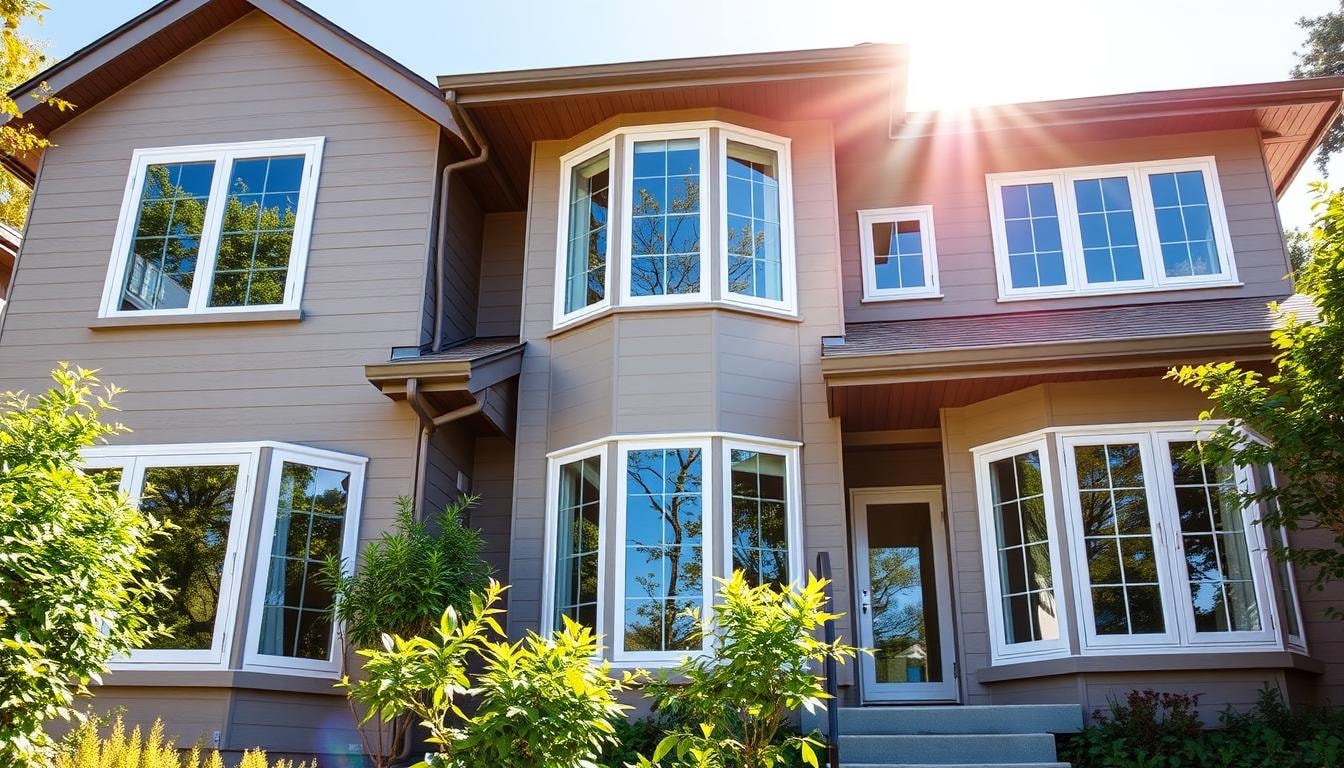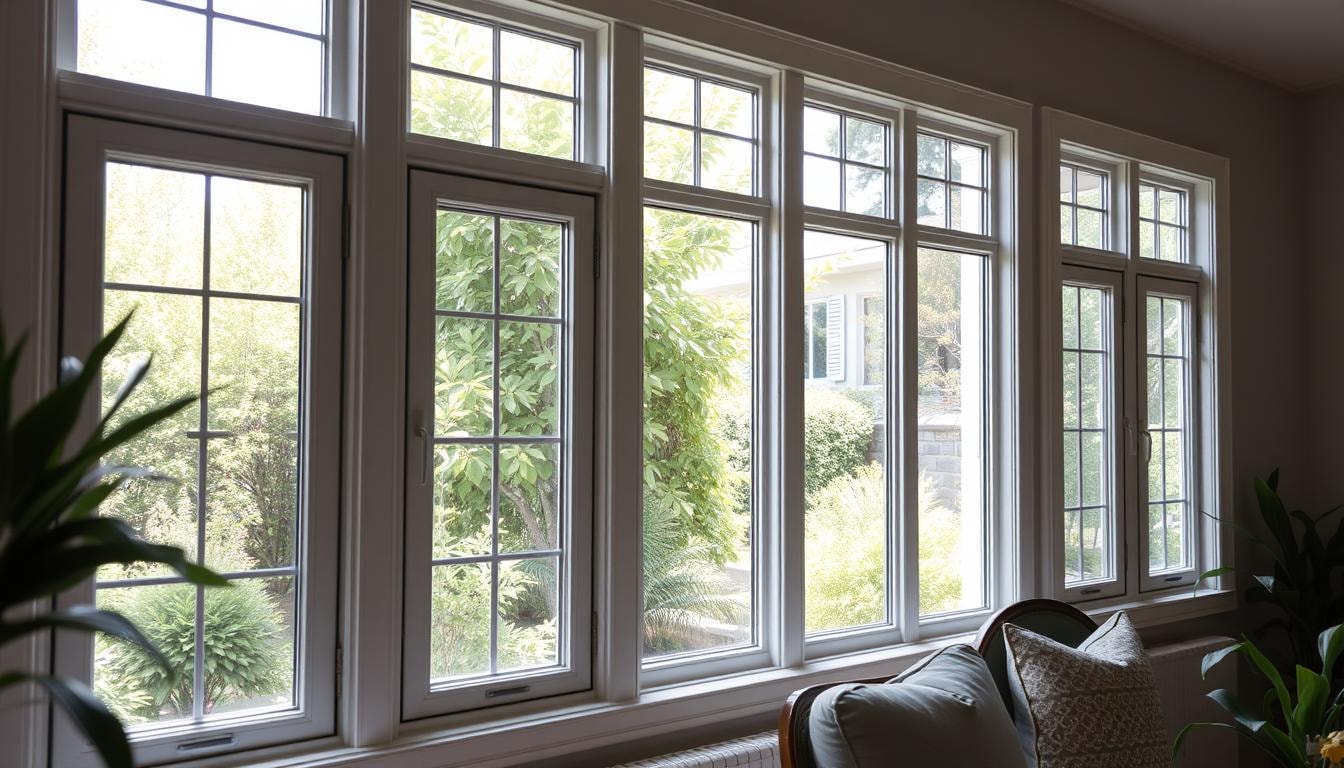
Replacement Windows for Your Home: A Guide to Choosing the Right Windows
Getting new windows can change how your home looks, saves energy, and boosts its value. Choosing the right windows means looking at many things. This includes materials, styles, energy-saving features, and how much they cost. This guide will help you understand what to look for. It will guide you in picking the best windows for your home.
Key Takeaways
- Vinyl windows are affordable and easy to care for. Wood windows add beauty and let you customize.
- Windows that save energy can cut down on bills by 30-50%. They use special coatings and gas.
- Choose windows that match your home’s style. This makes your home look better and work better.
- Make sure windows fit right. This improves the feel of a room and lets in more light and air.
- Think about the cost of new windows. Remember, they can save money in the long run and increase your home’s value.
Understanding Window Replacement Basics
Upgrading your home’s windows can be a big decision. You have to choose between new construction and replacement windows. New construction windows are for new builds or big renovations. Replacement windows fit into your current frames.
Knowing the parts of a window is important. It helps you pick the right ones for energy, durability, and function.
New Construction vs. Replacement Windows
New construction windows are bigger and more customizable. But, they need more work to install. Replacement windows fit your current frames, making installation easier.
Which one you choose depends on your project and budget.
Key Window Components
- Frame: The outer structure that holds the window in place, often made of materials like aluminum, composite, fiberglass, vinyl, or wood.
- Sash: The movable part of the window that holds the glass panes and allows for opening and closing.
- Glass: The transparent panel that allows for natural light and views, often enhanced with coatings or gas fills for improved energy efficiency.
- Hardware: The mechanisms, such as locks, latches, and hinges, that enable the window to function properly.
Window Anatomy Explained
Knowing the parts of a window is key. You need to think about the frame, glass, and weatherstripping. These affect the window’s energy use, durability, and how well it works.
Popular Window Styles for Modern Homes
Homeowners have many window styles to pick from. Each style has its own benefits. You can choose from classic double-hung windows to sleek slider windows. These options fit different home styles and tastes.
Double-hung windows are still loved for their versatility and ease of care. They have two moving parts. This lets you open them from the top or bottom. They look great in traditional and colonial homes.
Casement windows offer clear views and save energy. They open by swinging out from the sides. This makes them perfect for modern homes and kitchens, where they keep air in.
- Slider windows are modern and great for rooms near walkways or patios. They let in lots of light and air without taking up too much space.
- Bay and bow windows add depth and views. They’re great for cozy reading spots or extra seating in living rooms and dining rooms.
- Picture windows let in lots of light. They’re perfect for showing off backyards or gardens.
It’s key to pick a window style that matches your home’s look. This keeps your home looking good and might even raise its value. Talking to a pro can help you find the right windows for your home.
Energy Efficient Window Features
Getting the right windows can really help your home use less energy. These windows have special features like double or triple glazing. They also have low-e coatings and are filled with inert gas to keep warm in.
Double and Triple Glazing Benefits
Double glazing has two panes of glass with a space in between. This makes it better at keeping warm in than single-pane windows. Triple glazing adds another layer of glass. This makes it even better at keeping warm and saving energy.
Low-E Coating Technology
Low-emissivity (low-E) coatings are thin, invisible layers on the glass. They reflect infrared light to keep temperatures steady. These coatings can be changed for different climates, making them great for energy-saving windows.
U-Value and SHGC Ratings
When looking at energy-efficient windows, check the U-value and SHGC. The U-value shows how well a window keeps heat in. A lower U-value means better insulation. The SHGC shows how much solar heat a window lets in. A lower SHGC is better for warm places.
Windows with these features can make your home warmer and use less energy. This means lower bills and a cozier home.
Comparing Window Frame Materials
Homeowners have many choices for window frames. Each material has its own benefits and drawbacks. The right choice can affect a home’s energy use, looks, and upkeep needs.
- Wood Frames: Wood frames add a natural beauty to homes. They are good at keeping energy in, but need regular care to avoid damage.
- Vinyl Frames: Vinyl frames are cheap and keep energy in well. They need little care and are easy on the wallet.
- Aluminum Frames: Aluminum frames are strong and easy to care for. But, they don’t keep energy in as well as other materials.
- Fiberglass Frames: Fiberglass frames are strong, easy to care for, and keep energy in well. They cost less than wood but more than vinyl.
- Composite Frames: Composite frames mix materials for a good balance. They cost between vinyl and wood, keeping energy in well and needing little care.
Choosing the right window frame depends on your budget, home style, energy needs, and upkeep wants. Weighing each option’s pros and cons helps make the best choice for your home.
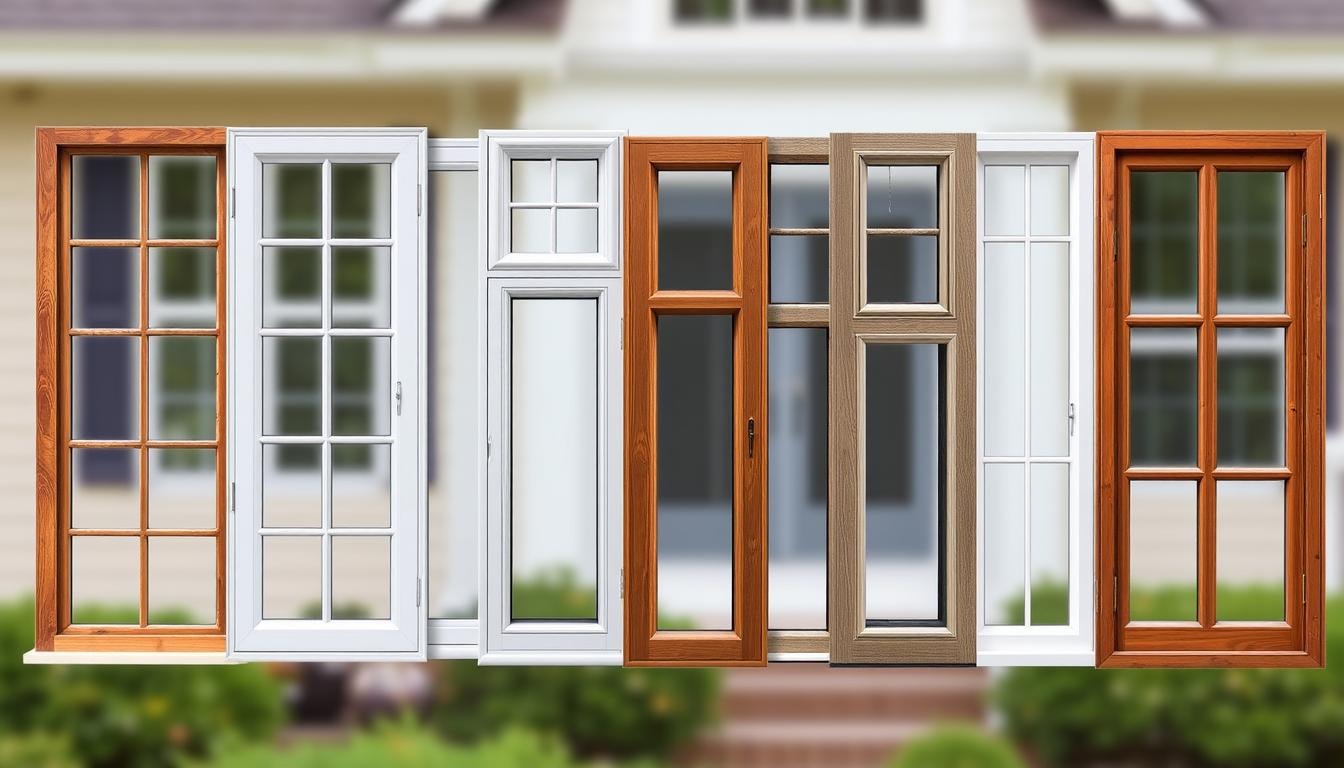
Common Window Sizes and Dimensions
Knowing the standard and custom window sizes is key for replacement or new homes. The right size windows match the wall and room size. This makes your home look good and feel right.
Standard Size Guidelines
Here are common sizes for single- or double-hung windows:
- 2 ft x 3 ft (2030)
- 2 ft x 4 ft 4 in (2044)
- 2 ft 8 in x 4 ft (2840)
- 2 ft 8 in x 5 ft 2 in (2852)
- 4 ft x 6 ft (4060)
Picture windows usually come in these sizes:
- 3 ft x 2 ft (3020)
- 5 ft x 3 ft (5030)
- 6 ft x 4 ft (6040)
- 4 ft x 5 ft (4050)
- 8 ft x 5 ft 2 in (8052)
Sliding windows are often:
- 3 ft x 2 ft (3020)
- 3 ft x 3 ft (3030)
- 5 ft x 3 ft (5030)
- 6 ft x 4 ft (6040)
- 7 ft x 4 ft (7040)
Custom Size Considerations
Custom sizes are needed for unique designs or energy goals. They fit your needs but cost more than standard sizes.
Choosing the right window size is crucial. It should match your home’s look and feel. Also, think about how size affects light, air flow, and your home’s beauty.
Cost Factors and Budget Planning
Window replacement costs can change a lot. The type, material, size, and energy features all affect the price. Vinyl windows are cheaper, while wood and clad-wood are pricier.
Energy-efficient windows might cost 10-15% more at first. But, they save money on energy bills over time. Homeowners should think about the cost and how it will save money and increase their home’s value.
It’s key to compare prices from different window companies. This helps find the best deal. Replacing windows when it’s not busy can also save money.
- Vinyl windows are affordable and low-maintenance
- Wood frames offer a classic look but are more expensive
- Aluminum frames are durable but can be costly
- Fiberglass frames are strong and energy-efficient but come at a premium
By looking at the cost factors and planning a budget, homeowners can make smart choices. They can balance their spending with the benefits of saving energy and increasing their home’s value.
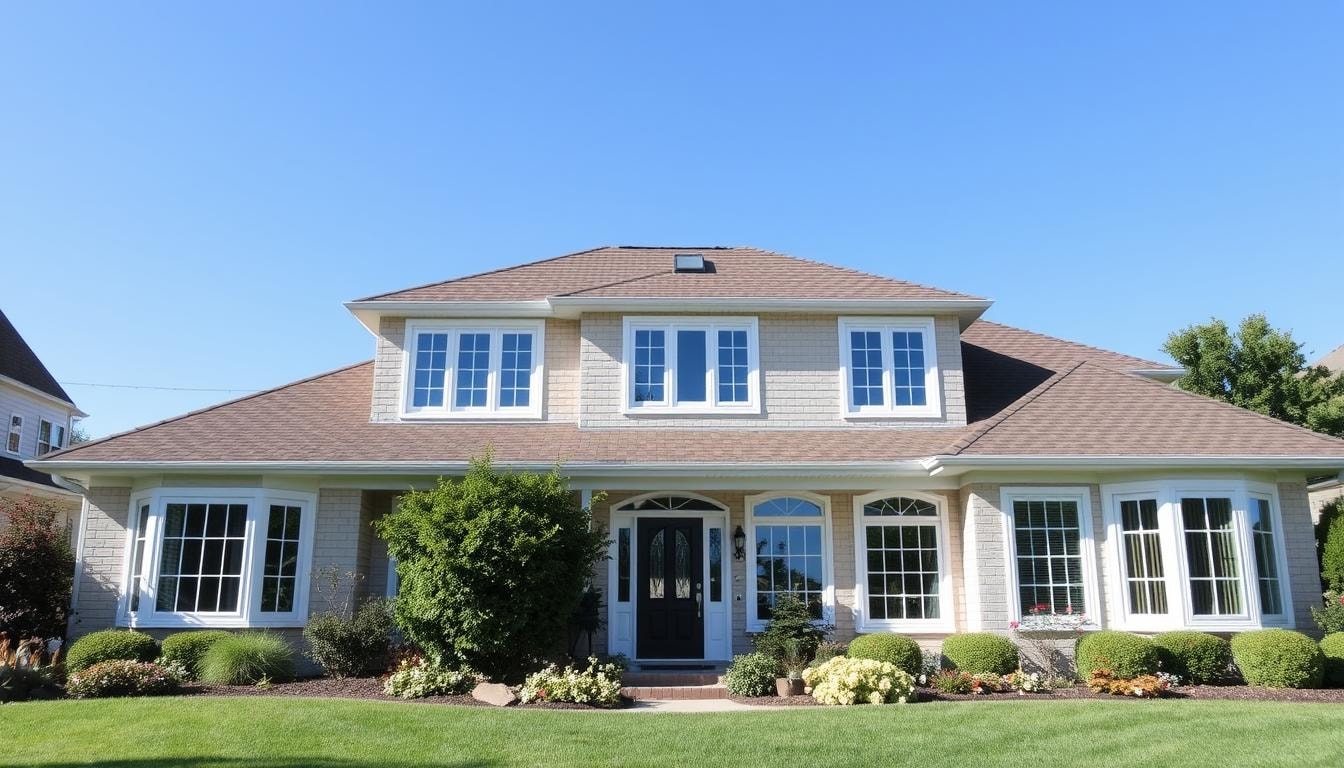
Installation Methods and Requirements
Getting your windows installed right is key for their best performance and life span. While most people choose professional installers, some DIY fans might try it themselves. Knowing how to install windows is important for getting the most out of your new ones.
Professional Window Installation
Choosing a pro for your window install has many benefits. Experts make sure your windows are sealed tight and fit perfectly. This stops air and water leaks. Plus, many window makers offer install guarantees for extra security.
Professionals are also great for tricky jobs like custom windows. They know how to handle these special cases.
DIY Window Installation
- If you’re handy and have done this before, DIY might work for you.
- But, if you mess it up, you could lose your warranty. So, follow the directions carefully.
- Trying to install in cold weather can be tough. Sealants and caulk might not work right.
Whether you do it yourself or hire a pro, the installation is critical. It affects your windows’ energy use and how long they last. Paying attention to details and making sure everything is sealed and weatherproofed is vital.
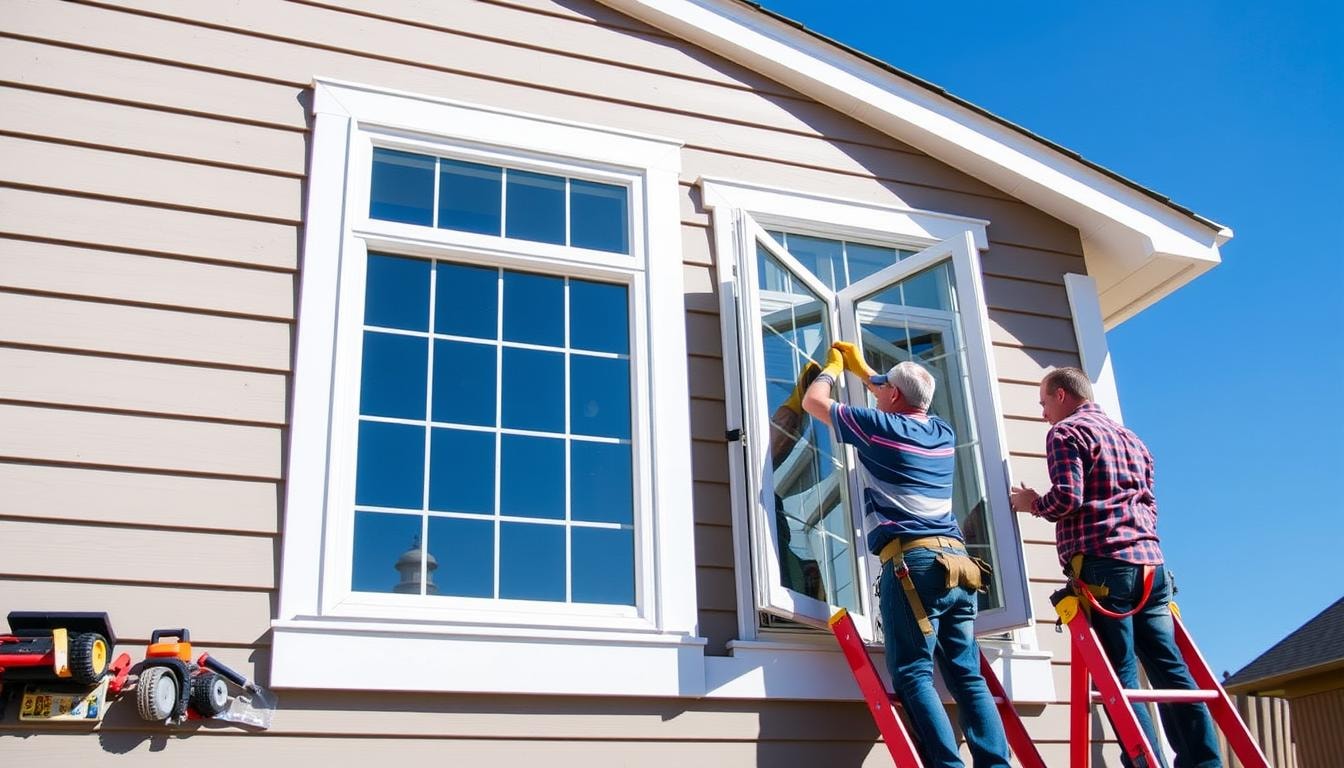
Maintenance and Care Guidelines
Keeping your windows in good shape is key for their long life and look. The care needed can change based on the material. But, a regular routine can make your windows last longer and work better.
Cleaning Best Practices
It’s important to clean your windows often to keep them looking good. The right cleaning method depends on the material. For vinyl, a mix of mild soap and water works well.
Wooden windows might need special cleaners to protect the finish. Double-hung windows with tilt-in sashes make cleaning from inside easier.
Long-term Maintenance Tips
- Check the weatherstripping often and replace it if it’s damaged to keep a good seal.
- Oil any moving parts, like window cranks or hinges, to keep them working smoothly.
- Look for signs of wear or damage, like cracks or loose parts, and fix them right away.
- Follow the maker’s advice for long-term care to keep your windows working well.
By sticking to these window maintenance and window cleaning tips, you can make your windows last longer. This way, you’ll get the most out of your long-term care for your home’s windows.
Window Safety and Security Features
When you replace windows, think about more than looks and energy savings. Safety and security are key. Modern windows have new ways to protect your home.
Impact-resistant glass is a top safety feature. It’s great for homes in areas hit by hurricanes. It keeps your home safe from strong winds and debris. It also makes it harder for intruders to get in.
- Multi-point locking systems on windows provide increased protection against break-ins, with multiple locking points along the frame for added security.
- Child safety locks are a essential feature to prevent accidental falls, especially in homes with young children.
- Egress windows in bedrooms allow for quick emergency exits, a crucial safety consideration.
- Some window manufacturers offer integrated security sensors that can connect to a home’s security system, providing an extra layer of protection.
Choosing new windows means picking the right mix of safety, security, and ease of use. A skilled window pro can help pick the best options for your home.
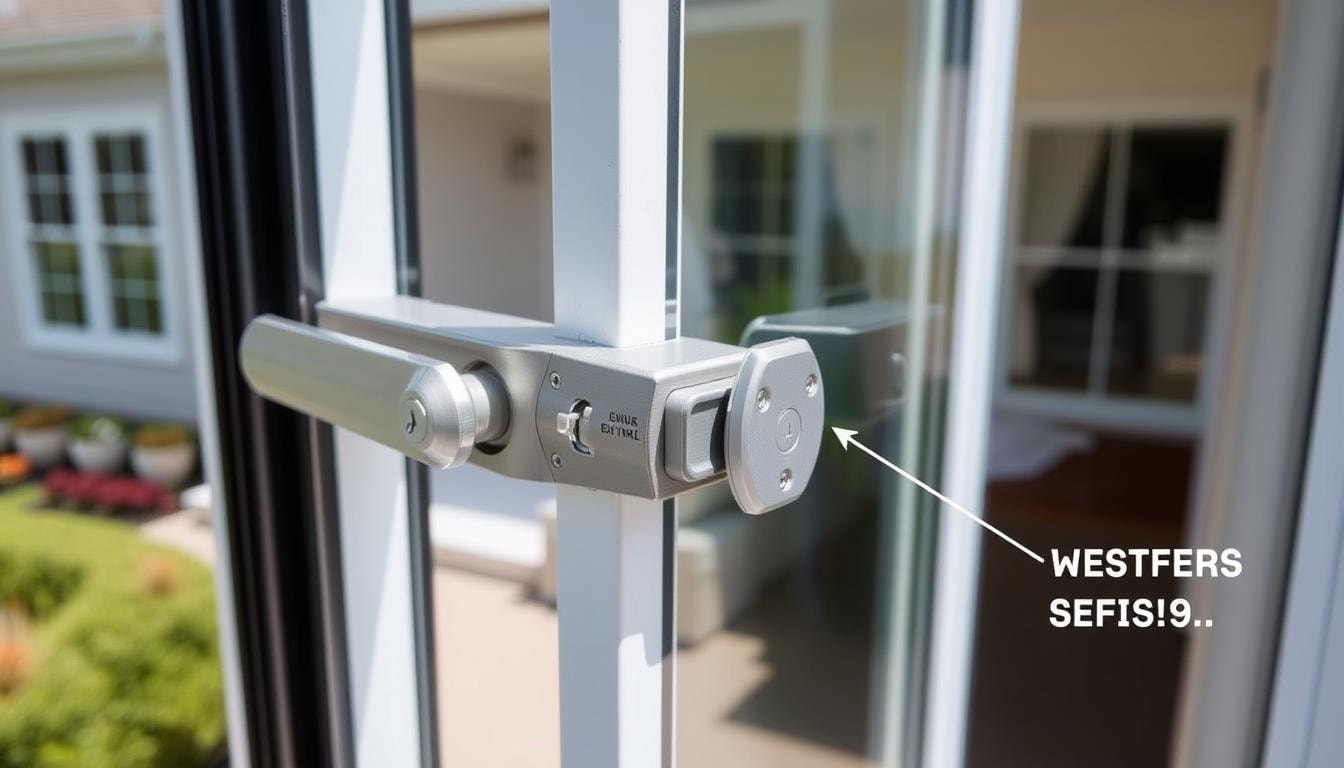
Enhancing Home Value with New Windows
Getting new windows can be a smart choice for homeowners wanting to increase their home’s value. The average return on investment (ROI) for new windows is about 70-80%. This makes it a very cost-effective home improvement.
Old, inefficient windows can cost a lot to run. New, energy-saving windows can cut down on these costs. This can make your home more valuable.
Return on Investment
Energy-efficient windows save money over time by lowering heating and cooling bills. This can make your home more valuable to buyers. They see the savings and like it.
New windows also make your home look better. This can make it more appealing to buyers. It might even sell for more.
Curb Appeal Benefits
New windows can make your home look better, boosting its curb appeal. Choosing the right style can make your home look good from the outside. This can attract more buyers.
Investing in new windows can make your home more desirable. It can also increase its resale value. It’s a smart way to improve your home.
Ready to Transform Your Home? Contact Budget Windows
At Budget Windows, our team of window and door experts is here to help you find the perfect solutions for your home. Whether you’re looking for energy-efficient vinyl replacement windows, classic Pella or Andersen designs, or modern sliding patio doors, we have the products and expertise to bring your vision to life.
Explore our selection of awning windows, garden windows, single-hung models, and more – all featuring high-quality materials, argon gas fills, and customizable grille patterns and exterior colors. Let us guide you through the process, from initial consultation to professional installation, ensuring a seamless and stress-free home improvement project.
Don’t settle for noisy, inefficient windows that detract from your home’s comfort and curb appeal. Contact Budget Windows today and speak with our knowledgeable team about transforming your space with top-of-the-line Simonton, Window World, and pocket replacement options. Make your next home project a success with the experts at Budget Windows.
Conclusion
Choosing the right replacement windows is all about finding the right mix. You need to think about style, function, energy saving, and cost. It’s important to pick windows that match your home’s look, the weather, and what you like.
Going for energy-saving features, like those with the ENERGY STAR label, can save you money and make your home cozier. These features help keep your home warm in winter and cool in summer.
Getting your windows installed by pros and keeping them up is key. This way, your windows will work well for a long time. Making smart choices about windows can make your home look better and save you money on energy bills.
Whether you prefer classic double-hung windows, sleek aluminum frames, or the beauty of wood, this window replacement guide is here to help. It will guide you in making a choice that fits your home improvement dreams and energy efficiency goals.
FAQs
What are the benefits of choosing sliding glass doors for my home?
Sliding glass doors are a modern and space-saving option that let in plenty of natural light and airflow, especially for rooms near patios or walkways. They offer unobstructed views and easy access to the outdoors.
How can I budget for the cost of replacement windows?
Replacement windows cost can vary widely based on factors like material, size, and energy-efficiency features. Vinyl replacement windows are generally the most affordable, while wood and clad-wood options are more expensive. Planning your budget and comparing quotes from multiple window companies can help you find the right balance of cost and value.
What are the advantages of choosing ENERGY STAR certified windows?
ENERGY STAR certified windows are designed to be highly energy-efficient, helping to lower your home’s heating and cooling costs. They often feature double or triple pane glass, low-E coatings, and gas fills like argon to improve insulation and reduce heat transfer. These certified windows can save you 30-50% on your energy bills.
How do I choose the right window materials for my home?
The window materials you select can impact your home’s aesthetic, energy efficiency, and maintenance needs. Vinyl is a budget-friendly and low-maintenance option, while wood adds classic beauty but requires more upkeep. Fiberglass and composite frames offer a balance of performance and cost. Consider your priorities, home style, and long-term care when comparing window materials.
What should I look for when hiring a window contractor?
When hiring a contractor for your window replacement project, look for one with experience, quality workmanship, and a good reputation. Check that they are licensed, insured, and can provide references. A reputable contractor will ensure your new windows are properly installed, sealed, and integrated with your home’s exterior and interior for optimal performance and aesthetics.





